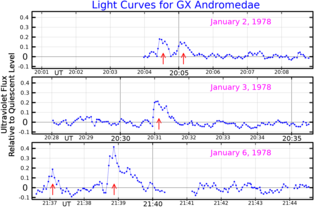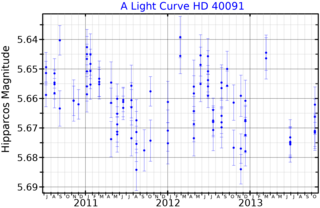
Groombridge 34 is a binary star system in the northern constellation of Andromeda. It was listed as entry number 34 in A Catalogue of Circumpolar Stars, published posthumously in 1838 by British astronomer Stephen Groombridge. Based upon parallax measurements taken by the Gaia spacecraft, the system is located about 11.6 light-years from the Sun. This positions the pair among the nearest stars to the Solar System.

2 Andromedae, abbreviated 2 And, is a binary star system in the northern constellation of Andromeda. 2 Andromedae is the Flamsteed designation. It is a faint star system but visible to the naked eye with a combined apparent visual magnitude of 5.09. Based upon an annual parallax shift of 7.7 mas, it is located 420 light years away. The binary nature of the star was discovered by American astronomer Sherburne Wesley Burnham at Lick Observatory in 1889. The pair orbit each other over a period of 74 years with a high eccentricity of 0.8.

28 Andromedae is a Delta Scuti variable star in the constellation Andromeda. 28 Andromedae is the Flamsteed designation. It also bears the variable star name GN Andromedae. Its apparent magnitude is 5.214, varying by less than 0.1 magnitudes.

HD 128311 is a variable star in the northern constellation of Boötes. It has the variable star designation HN Boötis, while HD 128311 is the star's designation in the Henry Draper Catalogue. The star is invisible to the naked eye with an apparent visual magnitude that fluctuates around 7.48. It is located at a distance of 53 light years from the Sun based on parallax, but is drifting closer with a radial velocity of −9.6 km/s. Two confirmed extrasolar planets have been detected in orbit around this star.

Gliese 105 is a triple star system in the constellation of Cetus. It is located relatively near the Sun at a distance of 23.6 light-years. Despite this, even the brightest component is barely visible with the unaided eye (see Bortle scale). No planets have yet been detected around any of the stars in this system.
Pi2 Cygni, Latinized from π2 Cygni, is a triple star system in the northern constellation of Cygnus. It is visible to the naked eye about 2.5° east-northeast of the open cluster M39, having an apparent visual magnitude of 4.24. Based upon an annual parallax shift of 2.95 mas, it is located at a distance of roughly 1,100 light years from the Sun.
HD 125072 is a star in the southern constellation of Centaurus. It is a challenge to view with the naked eye, having an apparent visual magnitude of 6.637. The star is located at a distance of 38.6 light years from the Sun based on parallax. It is drifting closer with a radial velocity of −14.9 km/s. The components of the space velocity for this star are U=−18.5, V=−6.9 and W=−26.9 km/s.

KK Andromedae, also known as HD 9531, is a variable star in the northern constellation of Andromeda. It has an apparent visual magnitude of 5.90, which places it near the lower limit of visibility to the naked eye even under good viewing conditions. An Alpha2 Canum Venaticorum variable, it varies in brightness by 0.012 magnitude every 0.66 days. Based upon an annual parallax shift of 7.5 mas as seen from Earth, it is located around 437 light years from the Sun. At that distance, the brightness of the star is diminished by an extinction of 0.26 magnitude due to interstellar dust.

LN Andromedae, also known as HD 217811, HR 8768, is a formerly suspected variable star in the constellation Andromeda. Located approximately 458 parsecs (1,490 ly) away from Earth, it shines with an apparent visual magnitude 6.41, thus it can be seen by the naked eye under very favourable conditions. Its spectral classification is B2V, meaning that it's a hot main sequence star, emitting light approximately with a blackbody spectrum at an effective temperature of 18,090 K.

V538 Aurigae is a single star in the northern constellation of Auriga. With an apparent visual magnitude of 6.23, this star requires good dark sky conditions to view with the naked eye. It is located at a distance of 40.0 light-years (12.3 pc) from Sun based on parallax. The star is drifting further away with a radial velocity of 0.9 km/s. It is a member of the Local Association, and is most likely a thin disk star.

Chi Ceti , is the Bayer designation for a double star in the equatorial constellation of Cetus. They appear to be common proper motion companions, sharing a similar motion through space. The brighter component, HD 11171, is visible to the naked eye with an apparent visual magnitude of 4.66, while the fainter companion, HD 11131, is magnitude 6.75. Both lie at roughly the same distance, with the brighter component lying at an estimated distance of 75.6 light years from the Sun based upon an annual parallax shift of 43.13 mass.

Omega1 Cygni, Latinized from ω1 Cygni, is the Bayer designation for a solitary star in the northern constellation of Cygnus. It is visible to the naked eye with an apparent visual magnitude of 4.94. Based upon an annual parallax shift of 2.59 mas, it is estimated to lie roughly 1,260 light years from the Sun. Relative to its neighbors, this star has a peculiar velocity of 25.7±2.2 km/s.

HD 93607 is a star in the constellation Carina. Its apparent magnitude is 4.87. Its parent cluster is IC 2602.

28 Monocerotis is a single star in the equatorial constellation of Monoceros. It has an orange-hue and is faintly visible to the naked eye with an apparent visual magnitude of 4.69. The distance to this star is approximately 450 light years based on parallax, and it has an absolute magnitude of −1.00. The star is drifting further away from the Sun with a radial velocity of +26.7 km/s.

9 Ceti is a star in the equatorial constellation of Cetus. It has the variable star designation BE Ceti, while 9 Ceti is the Flamsteed designation. It has an apparent visual magnitude of 6.4, which is below the limit that can be seen with the naked eye by a typical observer. Based upon parallax measurements, this star is 69.6 light years away from the Sun.
HD 219623 is a solitary star in the northern circumpolar constellation of Cassiopeia. HD 219623 is its Henry Draper Catalogue designation. It has an apparent visual magnitude of 5.59, which lies in the brightness range that is visible to the naked eye. According to the Bortle scale, it can be observed from dark suburban skies. Parallax measurements place it at an estimated distance of around 67.2 light years. It has a relatively high proper motion, advancing 262 mas per year across the celestial sphere.

GR Andromedae is a variable star in the constellation Andromeda. Its apparent visual magnitude varies between 6.87 and 6.95 in a cycle of 518.2 days. It is classified as an α2 Canum Venaticorum variable.

HN Andromedae is a variable star in the constellation Andromeda. Its apparent visual magnitude varies between 6.67 and 6.76 in a cycle of 69.51 days. It is classified as an α2 Canum Venaticorum variable.
HD 46815 is a solitary star in the southern constellation Columba. It is faintly visible to the naked eye with an apparent magnitude of 5.4 and is estimated to be 408 light years away. However, it is receding with a heliocentric radial velocity of 32.2 km/s.

HD 40091, also known as HR 2082, is a solitary star located in the southern constellation Columba, the dove. It has an apparent magnitude of 5.54, making it faintly visible to the naked eye under ideal conditions. Based on parallax measurements from the Gaia spacecraft, the object is estimated to be 501 light years distant. However, it is rapidly receding with a high heliocentric radial velocity of 114 km/s.
















